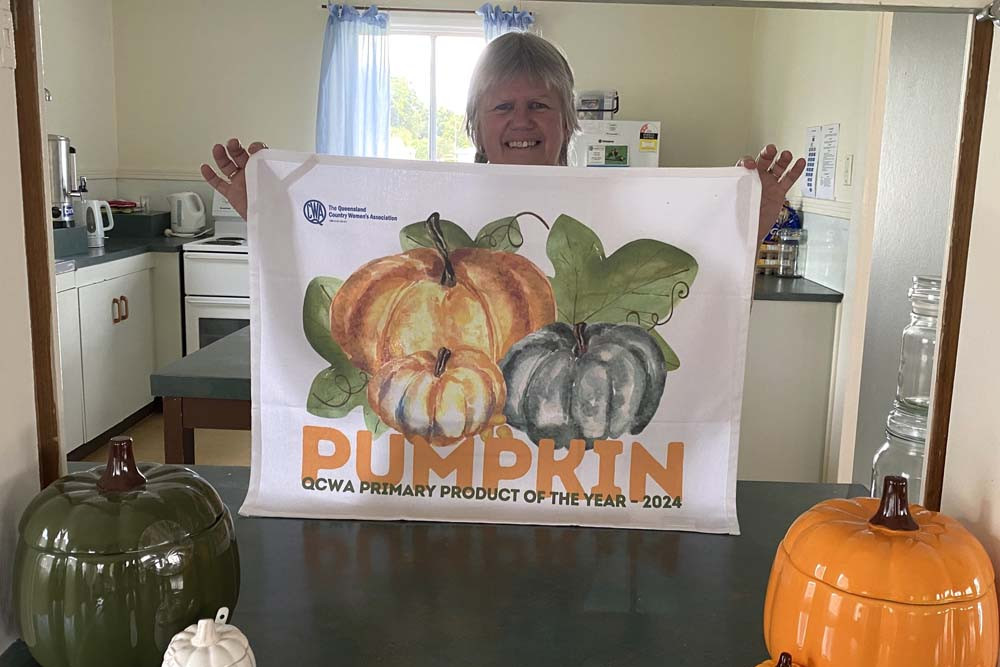On The Land
16 April, 2024
Pumpkin named primary product of the year
RECOGNISING its enduring popularity and versatility, pumpkin has been chosen by the Queensland Country Women's Association (QCWA) to be their 2024 Primary Product of the Year.

Since 2002, the association has chosen a primary product and has showcased and promoted it throughout the year.
Malanda Branch member and past State vice president Dr Christine Reghenzani OAM said the QCWA’s Agriculture and Environment Committee held a competition throughout the year to promote the chosen product.
“The Product of the Year Tea Towel competition aims to showcase the specially designed QCWA Pumpkin Tea Towel as an apron, but the tea towel is to be used whole - that is, not be cut up, and the apron is to be embellished with beautiful items from the member’s stash!” Christine said.
“QCWA Country Kitchens also contribute to the Primary Product of the Year.
“They produce an array of products such as an activities guide for members to promote the primary product, fun facts flip cards as an educational resource, a recipe booklet, a fun facts poster and a colouring sheet for children as a fun activity.”
Pumpkins have had a long association with QCWA, being synonymous with Lady Flo Bjelke-Petersen’s iconic pumpkin scone recipe.
The wife of former Queensland Premier, Sir Joh Bjelke-Petersen, and a prominent figure in Australian politics and culture, she was immortalised for this recipe which is still celebrated today as part of her legacy.
Lady Flo passed away in Kingaroy in 2017 aged 97, remaining a member of the QCWA and the Kingaroy Branch until the day she died.
She had stated that The Queen had eaten and loved them and had told, the now King Charles, that they may have been the reason why every time he visited Queensland he found that Sir Joh was still the Premier.
In her own words, Lady Flo had even used her pumpkin scones to resolve a dispute involving miners in a coal mine outside of Ipswich.
When Sir Joh would not agree to go underground into the mine to speak with the miners, Lady Flo whipped up a batch of pumpkin scones in the morning, wrapped them up in a “Lady Flo Pumpkin Scone Tea Towel” and went down into the mine to speak with the displeased miners.
As a result of her efforts, they came out of the mine to speak with Sir Joh, who then in turn, went down into the mine with the miners, which resulted in the strike soon coming to an end.
She called it “Pumpkin Scone Diplomacy”.
Native to the Americas, pumpkins were cultivated by indigenous peoples, including the Aztecs and Mayans, long before the arrival of European settlers.
They are one of the oldest known crops, having a history which dates back over 7,000 years.
These early civilisations used pumpkins not only for food, but also as containers and ornaments.
Pumpkins are consumed around the world in both savoury and sweet dishes. There are over 45 different varieties of pumpkins with the heaviest pumpkin ever recorded weighing an incredible 1,226 kg.
First brought into Australia in 1788 on the First Fleet, pumpkins are now the sixth most grown vegetable crop in Australia, with 120,981 tonnes produced each year.
In Australia, pumpkins are grown in every state, with Queensland being the biggest producer and accounting for roughly 40% of Australia’s pumpkin production.
“Here on the Atherton Tablelands the four major varieties of pumpkins grown are Jap (Kent), Jarrahdale, Butternut and Samson,” Christine said.
Pumpkins are part of the Cucurbitaceae or gourd family. They are botanically classified as a fruit, however nutritionally and on a culinary basis they are seen as a vegetable due to their flavour profile and nutrient content.
All parts of the pumpkin plant are edible, including the leaves, stem, flowers, seeds, skin and flesh. However, not all parts taste delicious, so discretion is advised.
Pumpkins comprise over 90% water, with each pumpkin containing around 500 seeds.
Remarkably, they were even once considered a remedy for freckles and snakebite.
A highly nutrient-dense vegetable, pumpkins are also prized for their flavour.
“Queensland Blue is a drier variety of pumpkin, which makes it great for steaming, boiling and baked goods,” Christine said.
"It’s particularly good when mashed for scones and cakes.”
Go to www.qcwacountrykitchens.com.au for great pumpkin recipes.
Lady Flo Bjelke-Petersen’s Pumpkin Scone Recipe
1 tbsp butter
½ cup sugar
¼ teaspoon salt
1 egg
1 cup mashed pumpkin (cold)
2-2 ¼ cups self-raising flour
Method: Beat together butter, sugar and salt using an electric mixer. Add egg, then pumpkin.
Finally stir in, by hand, sifted flour. Turn onto a floured board and cut. Place on a heated floured tray and cook on the top shelf of a very hot oven (225 -250 degrees Celsius) for 15-20 minutes.


